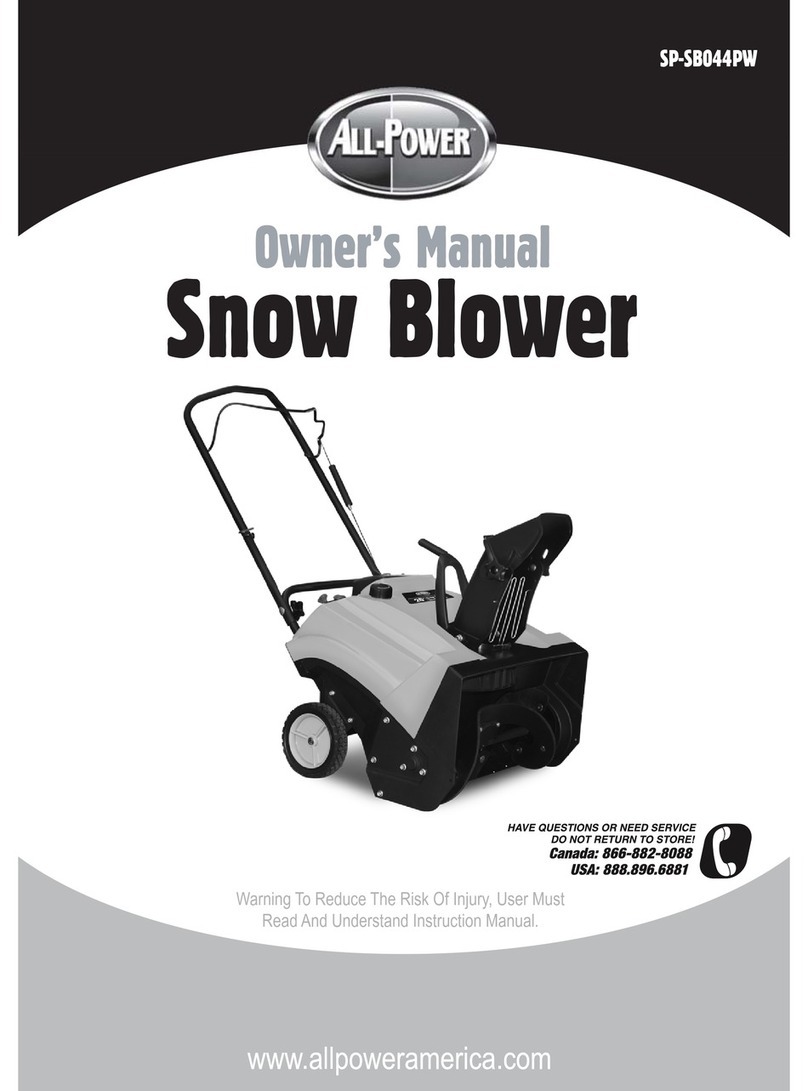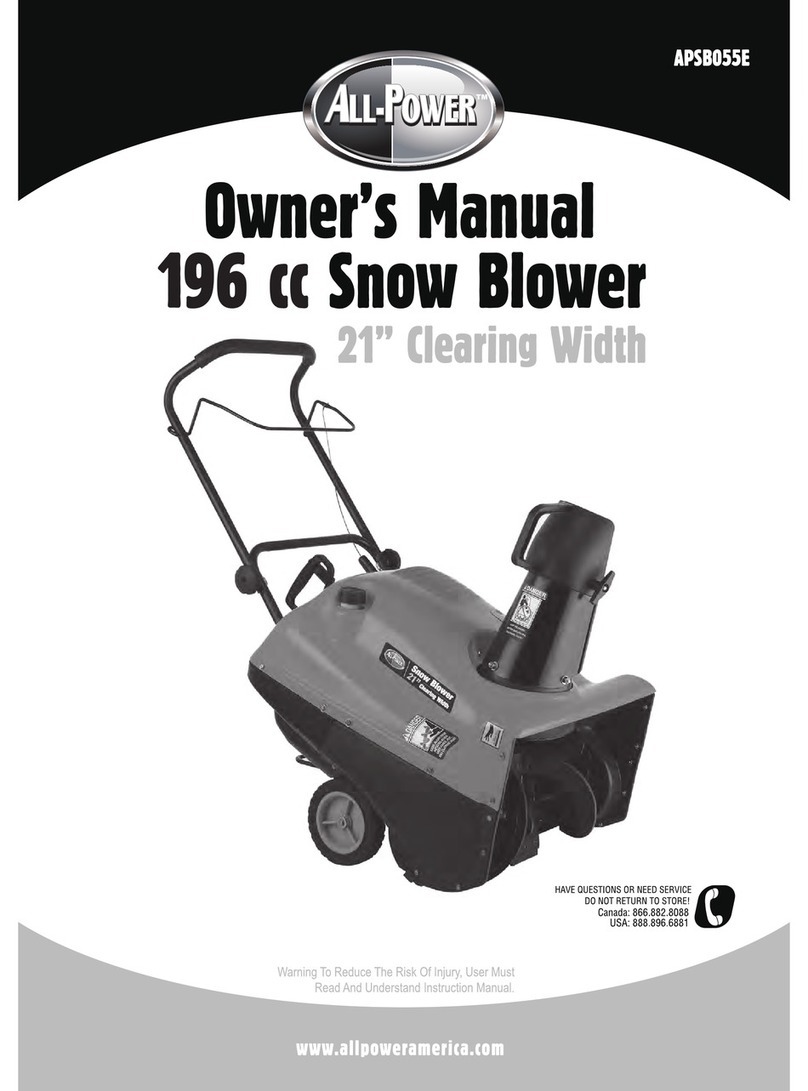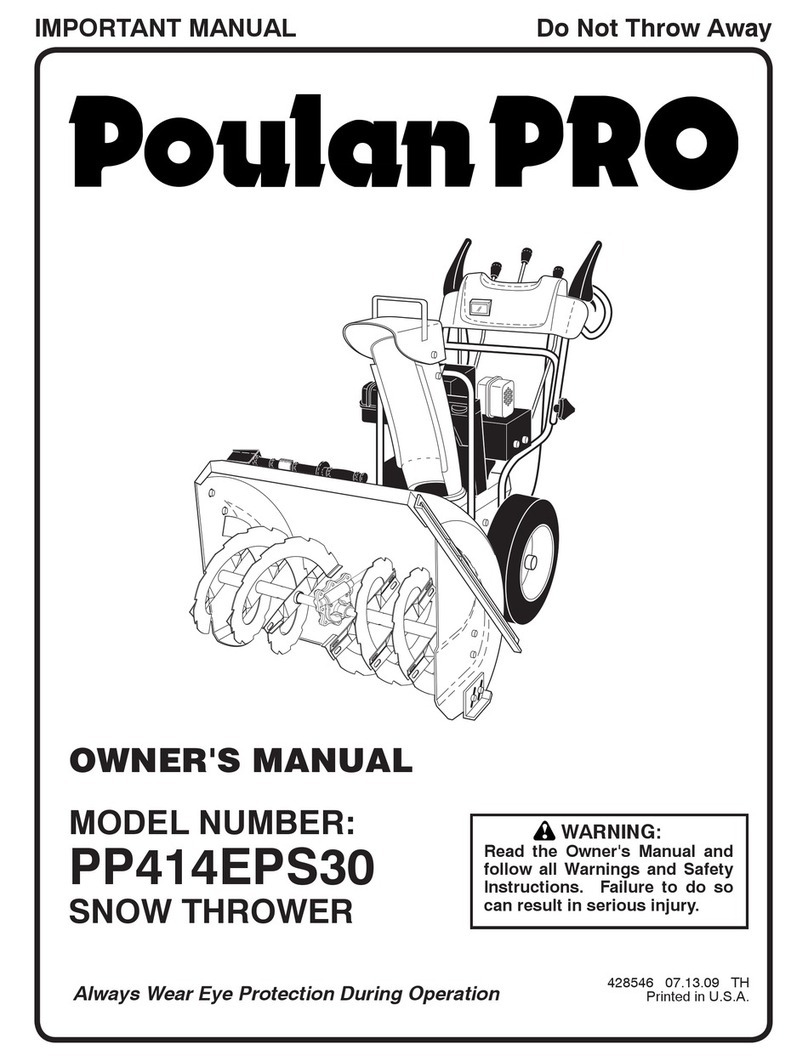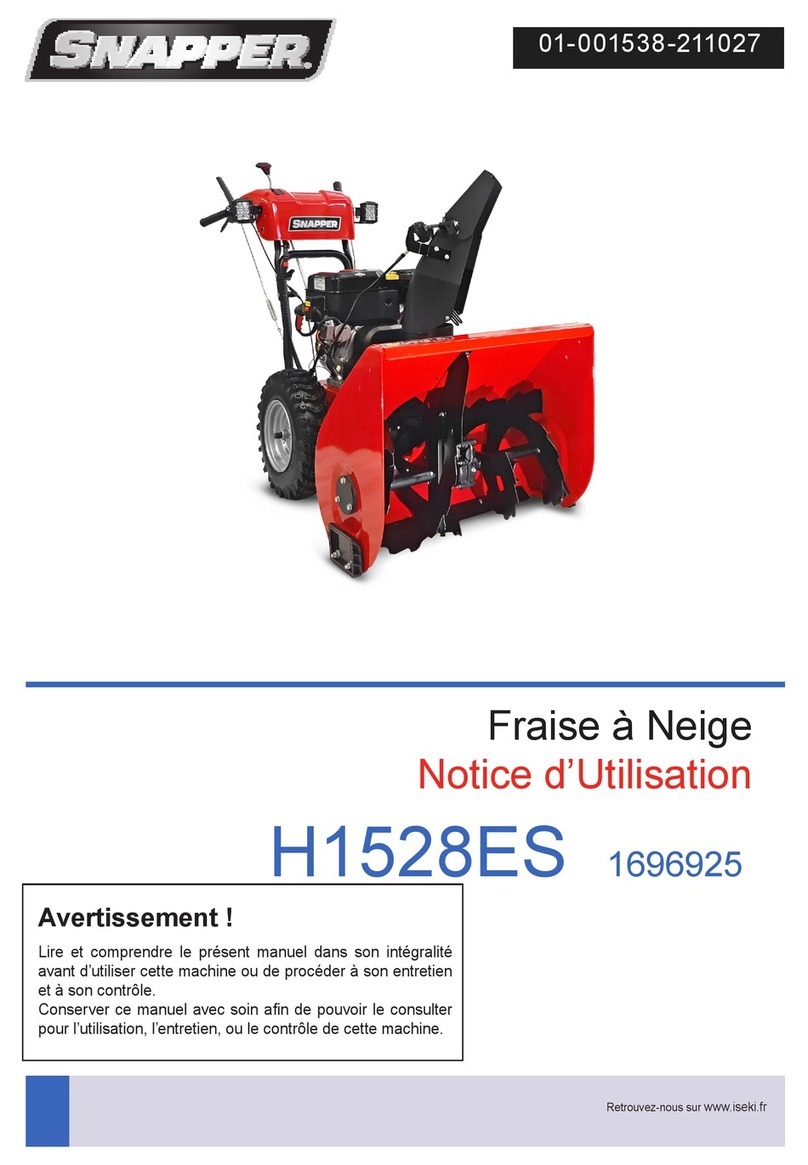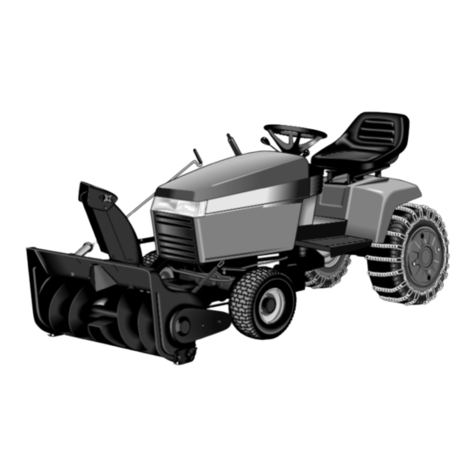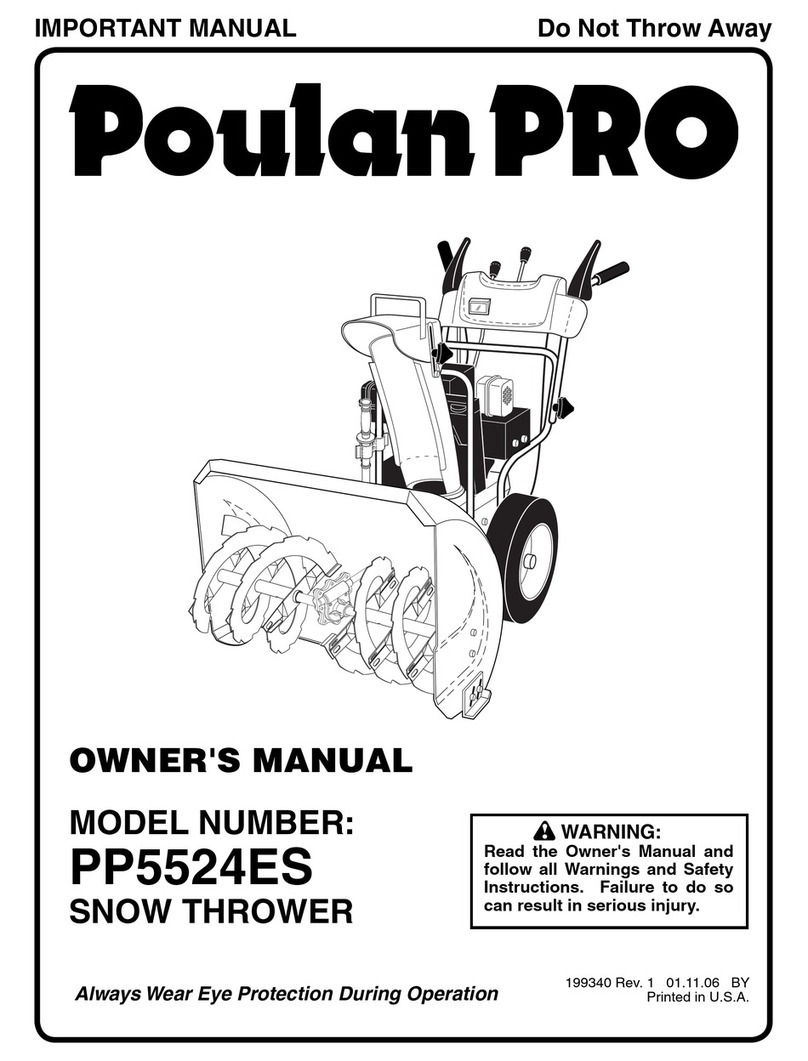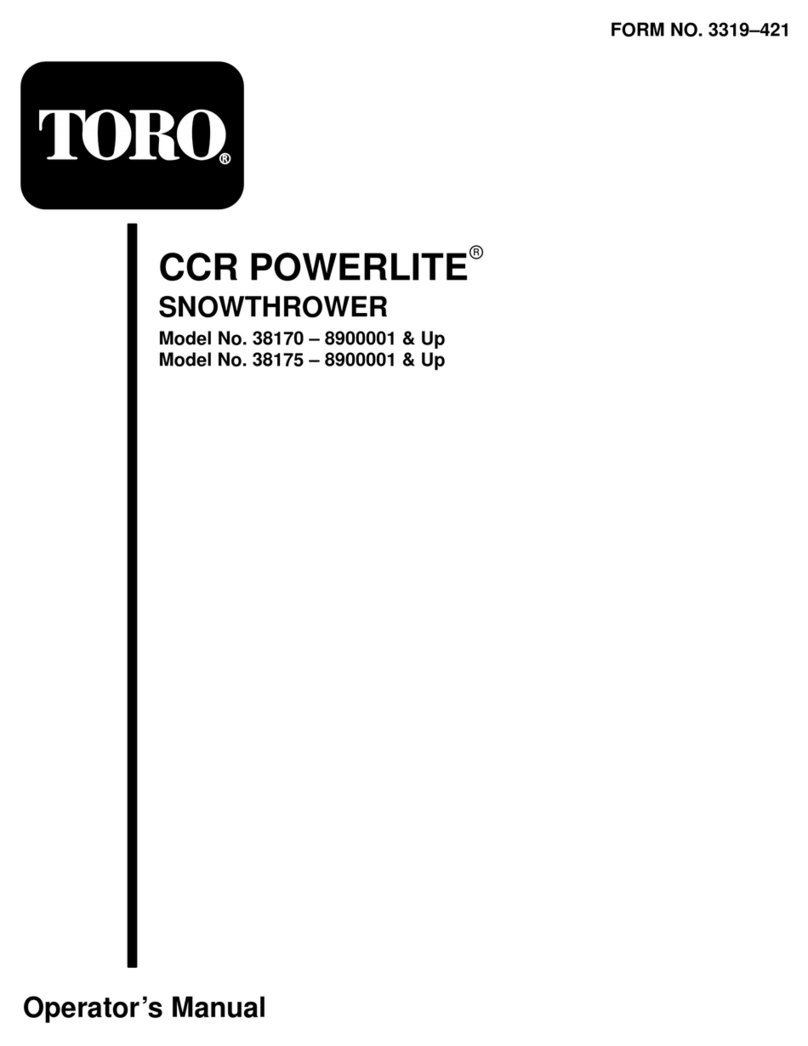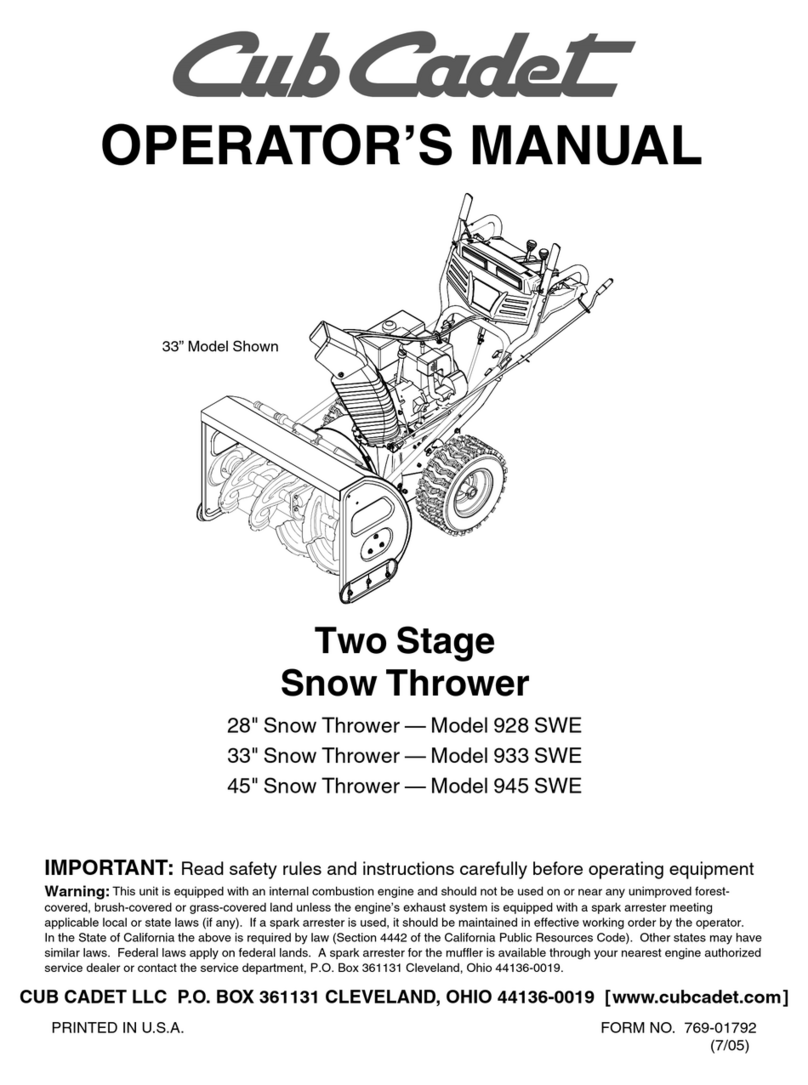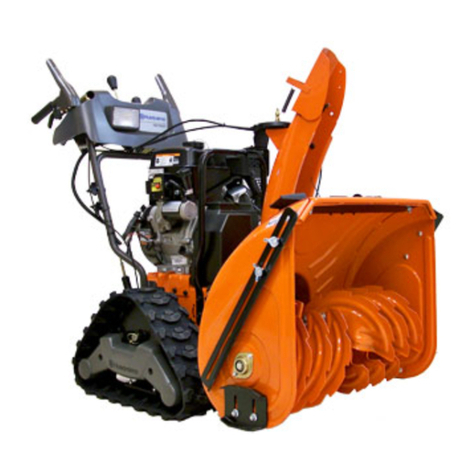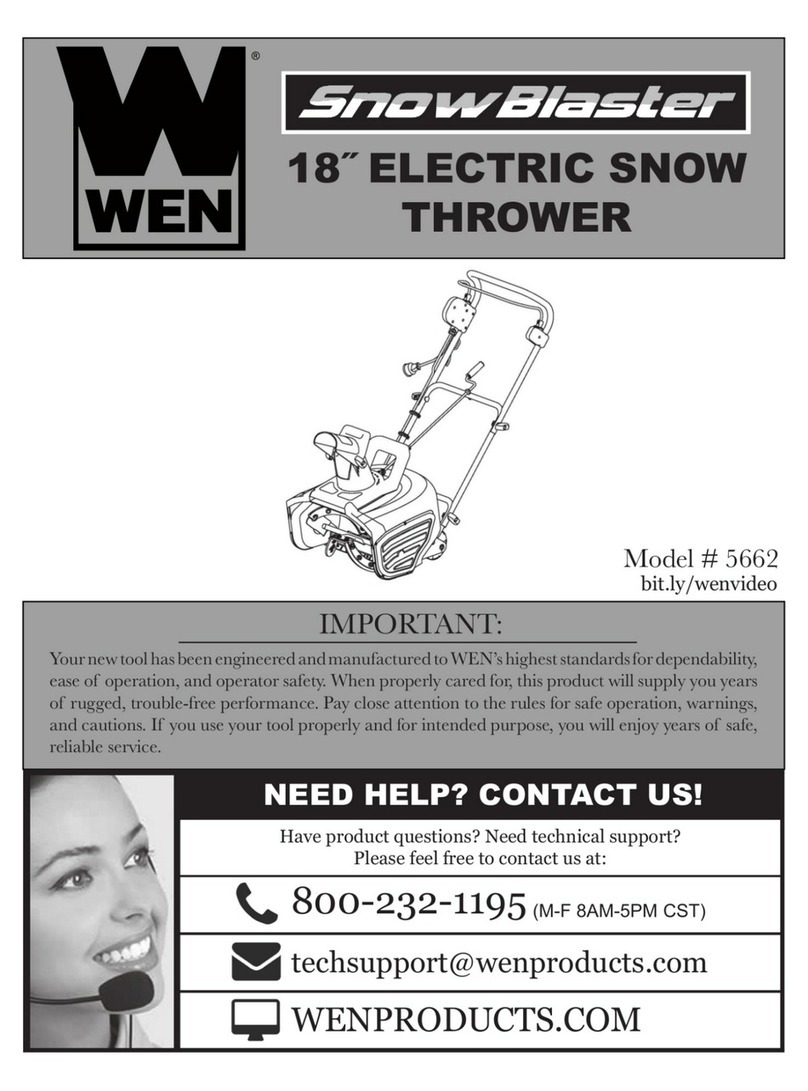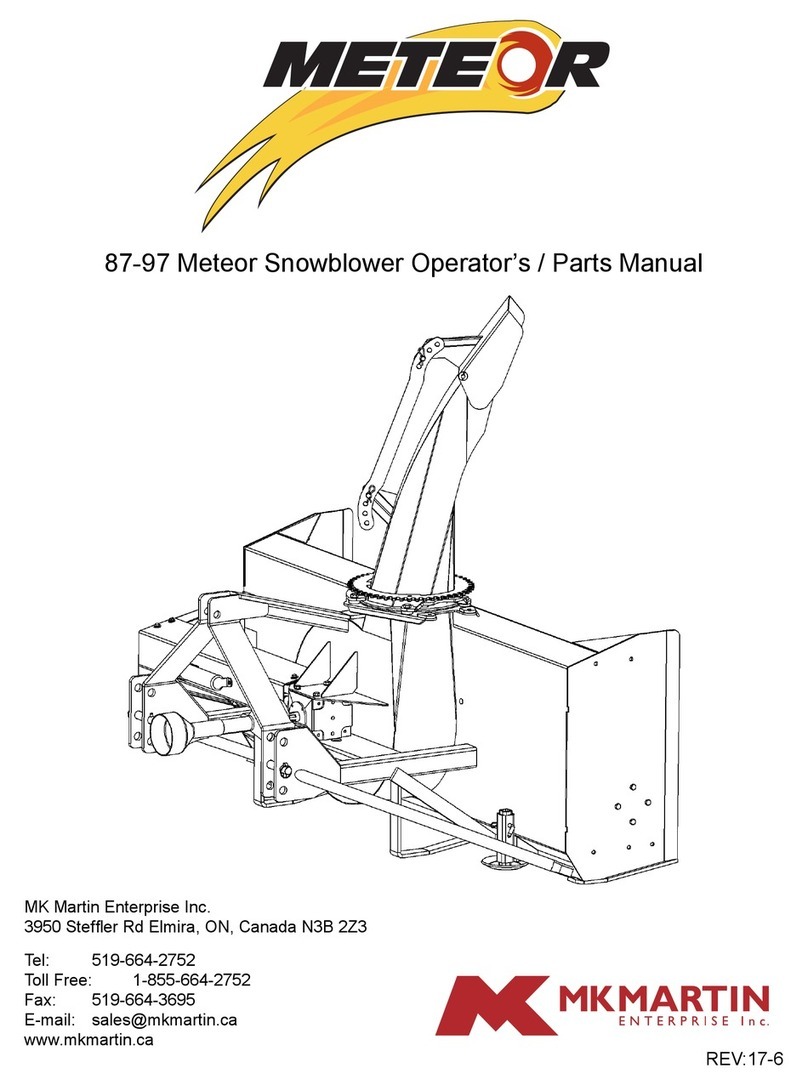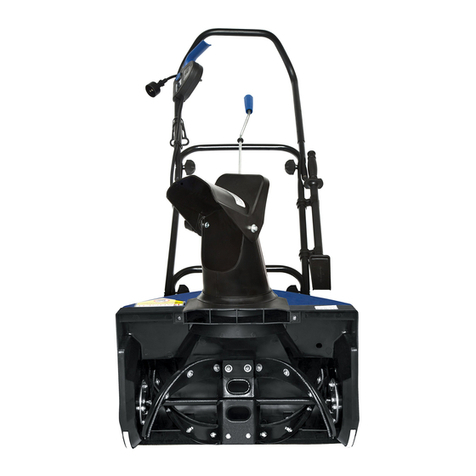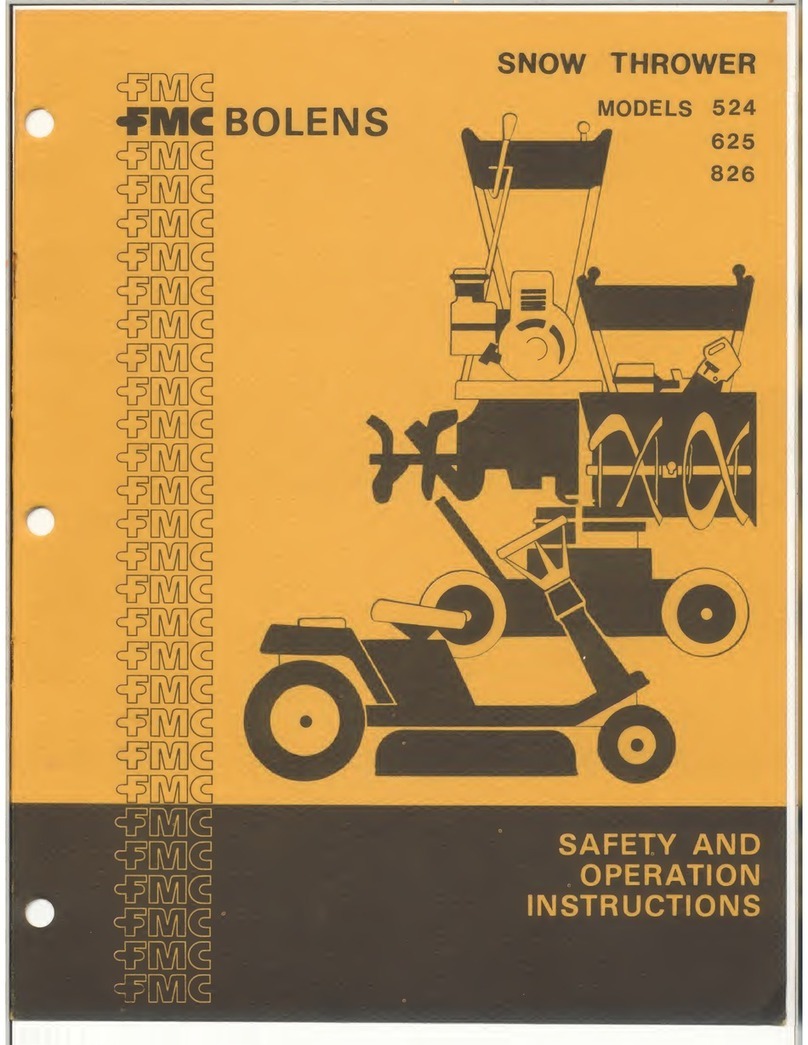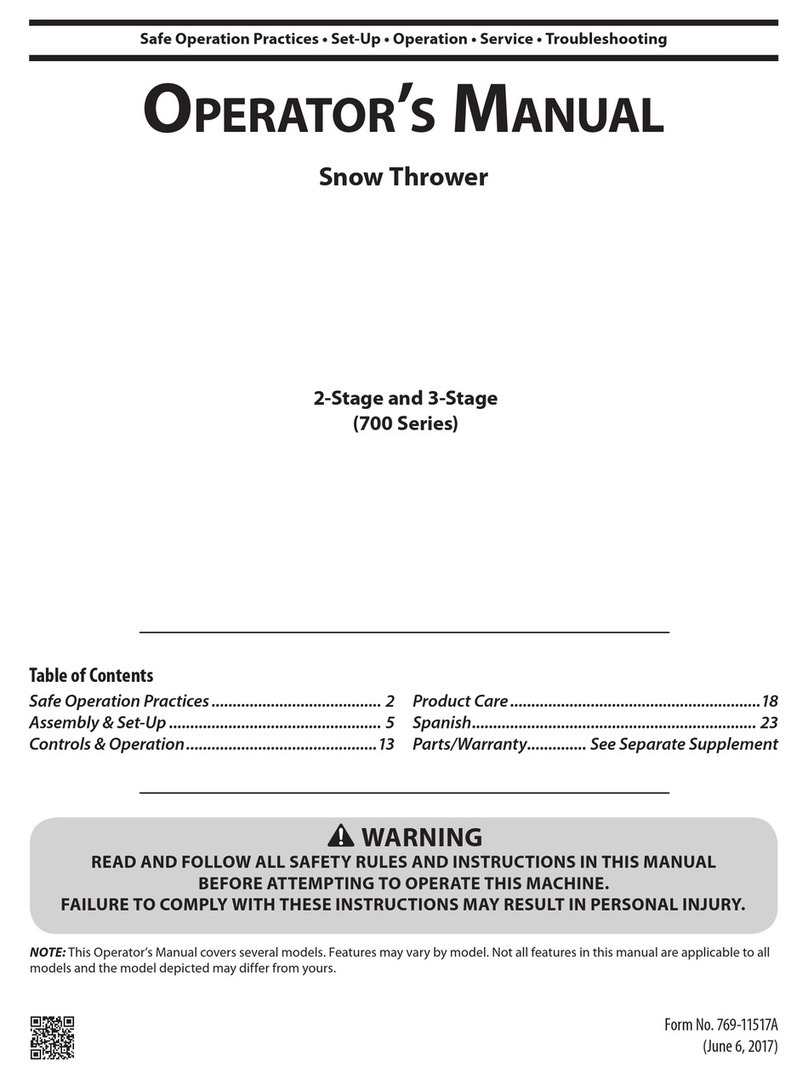ALLPOWER APSB2421 User manual

APSB2421
Snow Blower
Warning To Reduce The Risk Of Injury, User Must
Read And Understand Instruction Manual.

WARNING: Hot Surface, Do not touch!
Wear eye protection
Wear ear protection
Read the user manual
Wear gloves


DANGER: This machine was built to be operated according to the rules for safe
operation in this manual. As with any type of power equipment, carelessness or error on part of the
operator can result in serious injury. This machine is capable of amputating hands and feet and
throwing objects. Failure to observe the following safety instructions could result in serious injury
or death.
WARNING Engine Exhaust, some of its constituents, and certain vehicle components
contain or emit chemicals known to State of California to cause cancer and birth defects or
other reproductive harm.
WARNING: This symbol points out important safety instructions which, If not
followed, could endanger the personal safety and/or property of yourself and others. Read and
follow all instructions in this manual before attempting to operate this machine. Failure to comply
with these instructions may result in personal injury.When you see this symbol.HEED ITS
WARNING!
Your Responsibility:Restrict the use of this power machine to persons who read, understand
and follow the warnings and instructions in this manual and on the machine.
IMPORTANT
Safe Operation Practices for Walk-Behind Snow Throwers
This snow thrower is capable of amputating hands and feet and throwing objects. Failure to
observe the following safety instructions could result in serious injury.
Training
1. Read, understand, and follow all instructions on the machine and in the manual(s) before
attempting to assemble and operate this unit. Keep this manual in a safe place for future and
regular reference and for ordering replacement parts.
2. Be familiar with all controls and their proper operation. Know how to stop the machine and
disengage them quickly.
3. Never allow children under 14 years old to operate this machine. Children 14 years old and over
should read and understand the operation instruction and safety rules in this manual and should
be trained and supervised by parent.
4. Never allow adults to operate this machine without proper instruction.
5. Thrown objects can cause serious personal injury. Plan your snow-throwing pattern to avoid
discharge of material toward roads, bystanders and the like.
6. Keep bystanders, helpers, pets and children at least 75 feet from the machine while it is in
operation. Stop machine if anyone enters the area.
7. Exercise caution to avoid slipping or falling, especially when operating in reverse.
Preparation
1 . Thoroughly inspect the area where the equipment is to be used. Remove all doormats,
newspapers, sleds, boards, wires and other foreign objects, which could be tripped over or
thrown by the auger/impeller.
2. Always wear safety glasses or eye shields during operation and while performing an adjustment
or repair to protect your eyes. Thrown objects which ricochet can cause serious injury to the
eyes.
3. Do not operate the equipment without wearing adequate winter garments. Avoid loose fitting
SAFE OPERATION PRACTICES
SAFE OPERATION PRACTICE

clothing that can get caught in moving parts. Do not wear jewelry, long scarves or other loose
clothing, which could become entangled in moving parts. Wear footwear which will improve
footing on slippery surfaces.
4. Use a grounded three-wire extension cord and receptacle for all units with electric start engines.
5. Adjust collector housing height to clear gravel or crushed rock surfaces.
6. Disengage all clutches and shift into neutral before starting the engine.
7. Never attempt to make any adjustments while engine is running, except where specifically
recommended in the operator’s manual.
8. Let engine and machine adjust to outdoor temperature before starting to clear snow.
9. To avoid personal injury or property damage use extreme care in handing gasoline. Gasoline is
extremely flammable and the vapors are explosive. Serious personal injury can occur when
gasoline is spilled on yourself or your clothes, which can ignite. Wash your skin and change
clothes immediately.
a. Use only an approved gasoline container.
b. Extinguish all cigarettes, cigars, pipes and other sources of ignition.
c. Fill fuel tank outdoors with extreme care. Never fill fuel tank indoors.
d. Never remove gas cap or add fuel while the engine is hot or running.
e. Allow engine to cool at least two minutes before refueling.
f. Never over fill fuel tank. Fill tank to no more than 1/2 inch below bottom of filler neck to
provide space for fuel expansion.
g. Never fill containers inside a vehicle or on a truck or trailer bed with a plastic liner. Always
place containers on the ground, away from your vehicle, before filling.
h. When practical, remove gas-powered equipment from the truck or trailer and refuel it on
the ground. If this is not possible, then refuel such equipment on a trailer with a portable
container, rather than from a gasoline dispenser nozzle.
i. Keep the nozzle in contact with the rim of the fuel tank or container opening at all times,
until refueling is complete. Do not use a nozzle lock-open device.
j. Replace gasoline cap and tighten securely.
k. If gasoline is spilled, wipe it off the engine and equipment. Move machine to another area.
Wait 5minutes before starting the engine.
l. Never store the machine or fuel container inside where there is an open flame, spark or pilot
light(e.g. furnace, water heater, space heater, clothes dryer etc,)
m. Allow machine to cool at least 5 minutes before storing.
n. If fuel is spilled on clothing, change clothing immediately.
Operation
1. Do not put hands or feet near rotating parts, in the auger/impeller housing or chute assembly.
Contact with the rotating parts can amputate hands and feet. Keep clear of the discharge
opening at all times.
2. After striking a foreign object, stop the engine (motor), remove the wire from the spark plug,
disconnect the cord on electric motors, thoroughly inspect the snow thrower for any damage,
and repair the damage before restarting and operating the snow thrower.
3. Stop the engine (motor) whenever you leave the operating position, before unclogging the
collector/impeller housing or discharge chute, and when making any repairs, adjustments or
inspections.
4. When cleaning, repairing or inspecting the snow thrower, stop the engine and make certain the
collector/impeller and all moving parts have stopped. Disconnect the spark plug wire and keep
the wire away from the plug to prevent someone from accidentally starting the engine
5. The auger/impeller control lever is a safety device. Never bypass its operation. Doing so
makes the machine unsafe and may cause personal injury.
6. The control levers must operate easily in both directions and automatically return to the
disengaged position when released.
7. Never operate the snow thrower without proper guards, and other safety protective devices in
place and working.
8. Never run an engine indoors or in a poorly ventilated area. Engine exhaust contains carbon
monoxide, an odorless and deadly gas.
SAFE OPERATION PRACTICES

9. Do not operate machine while under the influence of alcohol or drugs.
10. Exercise extreme caution when operating on or crossing gravel surfaces. Stay alert for hidden
hazards or traffic.
11. Exercise caution when changing direction and while operating on slopes.
12. Plan your snow-throwing pattern to avoid discharge towards windows, walls, cars etc. Thus,
avoiding possible property damage or personal injury caused by a ricochet.
13. Never direct the discharge toward people or areas where property damage can occur. Keep
children and others away.
14. Do not overload machine capacity by attempting to clear snow at too fast of a rate.
15. Never operate this machine without good visibility or light. Always be sure of your footing
and keep a firm hold on the handles. Walk, never run.
16. Disengage power to the auger/impeller when transporting or not in use.
17. Never operate machine at high transport speeds on slippery surfaces. Look down and behind
and use care when backing up.
18. If the machines should start to vibrate abnormally, stop the engine, disconnect the spark plug
wire and ground it against the engine. Inspect thoroughly for damage. Repair any damage
before starting and operating.
19. Disengage all control levers and stop engine before you leave the operating position(behind
the handles). Wait until the auger/impeller comes to a complete stop before unclogging the
chute assembly, making any adjustments, or inspections.
20. Never put your hand in the discharge or collector openings. Always use the clean-out tool
provided to unclog the discharge opening. Do not unclog chute assembly while engine is
running. Shut off engine and remain behind handles until all moving parts have stopped before
unclogging.
21. Use only attachments and accessories approved by the manufacturer (e.g. wheel weights, tire
chins, cabs etc.).
22. Never touch a hot engine or muffler
23. If situations occur which are not covered in this manual, use care and good judgment. Contact
your Sears Service Center for assistance.
Clearing a Clogged Discharge Chute
Hand contact with the rotating impeller inside the discharge chute is the most common cause of
injury associated with snow throwers. Never use your hand to clean out the discharge chute.
To clear the chute:
1. SHUT THE ENGINE OFF!
2. Wait 10 seconds to be sure the impeller blades have stopped rotating.
3. Always use a clean-out tool, not your hands
Maintenance & Storage
1. Never tamper with safety devices. Check their proper operation regularly. Refer to the
maintenance and adjustment sections of this manual.
2. Before cleaning, repairing, or inspecting machine disengage all control levers and stop the
engine. Wait until the auger/impeller come to a complete stop. Disconnect the spark plug wire
and ground against the engine to prevent unintended starting.
3. Check bolts and screws for proper tightness at frequent intervals to keep the machine in safe
working condition. Also, visually inspect machine for any damage.
4. Do not change the engine governor setting or over-speed the engine.
5. Snow thrower shave plates and skid shoes are subject to wear and damage. For your safety
protection, frequently check all components and replace with original equipment manufacturer’s
(OEM) parts only. ”Use of parts which do not meet the original equipment specifications may
lead to improper performance and compromise safety!”
6. Check controls periodically to verify they engage section in this operator’s manual for
instructions.
7. Maintain or replace safety and instruction labels, as necessary.
8. Never store the machine with fuel in the fuel tank inside a building where ignition sources are
present such as hot water heaters, space heaters, or clothes dryers. Allow the engine to cool
before storing in any enclosure.
8. Observe proper disposal laws and regulations for gas, oil, etc. to protect the environment.
9. Prior to storing, run machine a few minutes to clear snow from machine and prevent freeze

up of auger/impeller.
10. Never store the machine or fuel container inside where there is an open flame, spark or pilot
light such as a water heater, furnace, clothes dryer etc.
11. Always refer to the operator’s manual for proper instructions on off-season storage.
Do not modify engine
To avoid serious injury or death, do not modify engine in any way. Tampering with the governor
setting can lead to a runaway engine and cause it to operate at unsafe speeds. Never tamper with
factory setting of engine governor.

Assembly:
1 Mount the armrest: first unscrew the nut, put in order four bores on the upper armrest,
plug in the bolt and screw it with a nut.
3 Mount the connecting rod: pull out pinchcock and pin bearing, drill through a bore on
the connecting rod with a pin bearing, plug and fix the pinchcock in the pin bearing,
and screw the other side on the connecting rod with a nut.
1)Nut and bolt
2)Armrest
1
2
3
1)Connecting Rod
2)Pinchcock
3)Nut
2
1

4 Mount the moving wire and auger wire: Connecting the Moving wire and Auger Wire
on the left and right side position
1)Moving Wire
2)Auger Wire
5 Mount the chute: place it on the chute seat, put down a fixed block to aim with a bore,
and screw the fixed block with a bolt.
1)Bore
2)Bolt
1
2
12

1. Drive Control
2. Auger Control
3. Chute Direction Control
4. Speed Control
5. Skid Shoes
6. Auger
7. Chute Control
1
2
4
7
5
3
6

WARNING:Read, understand, and follow all instructions and warnings
on the machine and in this manual before operating.
Shift Lever
R11 2 3 4 Figure1
The shift lever is located between the lower handles. Place the shift lever into any of seven positions
to control the direction of travel and ground speed.
Forward
There are five forward (F) speeds. Position one (1) is the slowest and position five (5) is the fastest.
Reverse
There are two reverse (R) speeds. One (1) is the slower and two (2) is the faster.
Primer
Depressing the primer forces fuel directly into the engine’s carburetor to aid in cold-weather
starting.
Choke Control
Figure2
The choke control is found on the rear of the engine and is activated by rotating the knob clockwise.
Activating the choke control closes the choke plate on the carburetor and aids in starting the
engine.See figure 2
Throttle Control
The throttle control is located on the engine.
It regulates the speed of the engine and will
shut off the engine when pushed down completely.
See figure 3
OPERATING YOUR SNOW THROWER
Auger Control
The auger control is located on the left handle. Squeeze the control grip against the handle to engage
the augers and start snow throwing action. Release to stop.see figure 4
Drive Control
Figure3
Figure4

The drive control is located on the right handle. Squeeze the control grip against the handle to
engage the wheel drive. Release to stop.see figure 5
Chute Directional Control
The chute directional control is located on the panel of the snow thrower.
To change the direction in which snow is thrown, turn chute directional control as follows:
Crank clockwise to discharge to the right.
Crank counterclockwise to discharge to the left.see figure 6
Clean-Out Tool
WARNING:Never use your hands to clear a clogged chute assembly. Shut off
engine and remain behind handles until all moving parts have stopped before unclogging.
The chute clean-out tool is fastened to the top of the auger housing with a mounting clip. The tool is
designed to clear a clogged chute assembly.
OPERATING YOUR SNOW THROWER
Skid Shoes
Position the skid shoes based on surface conditions. Adjust upward for hard-packed snow. Adjust
downward when operating on gravel or crushed rock surfaces.
Recoil Starter Handle
This handle is used to annually start the engine
Electric Starter Outlet (equipped on some units not all)
Requires the use of a three-prong outdoor extension cord(included)and a 120V power source.(US
market)
Augers
When engaged, the augers rotate and draw snow into the auger housing
Chute Assembly
Snow drawn into the auger housing is discharged out the chute assembly
Gas Cap
Unthread the gas cap to add gasolineto the fuel tank
Oil Fill
Engine oil level can be checked and oil added through the oil fill!
Before Starting Engine
Do not start the engine until filled with oil. The engine can be seriously be damaged without oil.
1. Place the machine on a level floor.
2. Loosen the dipstick and read the oil level. See fig 7

3. The oil level shall be between the marks “HIGH” and “LOW”. See fig 7
4. If necessary fill with oil up to the FULL mark .See fig.11.
5. Use good quality oil marked A.P.I. service SF ,SG or SH.
Use SAE 5W30 oil . Use SAE OW30 oil for temperatures under – 18
Do not use SAE 10W40.
Gasoline
WARNING:Use extreme care when handling gasoline is extremely flammable
and the vapors are explosive. Never fuel the machine indoors or while the engine is hot or
running. Extinguish cigarettes, cigars ,pipes and other sources of ignition.
OPERATING YOUR SNOW THROWER
·Store gasoline in a clean, approved container and keep the cap in place on the container.
·Make sure that the container form which you pour the gasoline is clean and free from rust or
other foreign particles.
NOTE: A plastic dust cap may be found inside the fuel fill opening .
Remove and discard, if present.
·Always fill the fuel tank outdoors and use a funnel or spout to prevent spilling.
·Fill fuel tank with clean, fresh ,unleaded gasoline.
·Never fill the fuel tank completely. Fill the tank to within 1/2”from the top to provide space for
expansion of fuel.
·Make sure to wipe off any spilled fuel before starting the engine.
Starting The Engine
1. Attach spark plug wire to spark plug. Make certain the metal loop on the end of the spark plug
wire (inside the rubber boot) is fastened securely over the metal tip on the spark plug.
2. Make certain both the auger control and drive control are in the disengaged (released) position.
3. Move throttle control up to FAST position. Insert ignition key into slot. Make sure it snaps into
place. Do not attempt to turn the key.
NOTE : The engine cannot start without the key being fully inserted into the ignition switch.
Electric Starter
1. Determine that your home’s wiring is a three-wire grounded system.
Ask a licensed electrician if you are not certain.
WARNING: The optional electric starter is equipped with a grounded three-
wire power cord and plug ,and is designed to operate on 120 volt AC household current. It
must be used with a properly grounded three-prong receptacle at all times to avoid the
possibility of electric shock.
If your home’s wiring system is not a three-wire grounded system, do not use this electric
starter under any conditions.
If your home electrical system is grounded, but a three- hole receptacle is not available,
do not use your snow thrower’s electric starter.
Follow all instructions carefully prior to operating the electric starter.
If you have a grounded three-prong receptacle, proceed as follows:
1. Plug the extension cord into the outlet located on the engine’s surface. Plug the other end of
extension cord into a three-prong 120-volt, grounded, AC outlet in a well-ventilated area.
2. Rotate choke control to FULL choke position (for a cord engine start).
NOTE: If the engine is already warm , place choke control in the OFF position instead of FULL
3. Push the primer to restart a warm engine start, marking sure to cover vent hole in the center of
the primer when pushing .
NOTE: DO NOT use primer to restart a warm engine after a short shutdown.
OPERATING YOUR SNOW THROWER
4. Push start button to start engine.
5. Once the engine starts release starter button.
6. As the engine warms, slowly rotate the choke control to the OFF position . If the engine falters,
quickly rotate the choke control back to FULL and then slowly into the OFF position again.

7. When disconnecting the extension cord, always unplug the end at the three-prong wall outlet
unplugging the opposite end form the snow thrower.
Recoil Starter
1. Rotate choke control to FULL choke position (cold engine start).
NOTE: If the engine is already warm, place choke control in the OFF position instead of FULL.
2_Push the primer two or three times for cold engine start, making sure to cover vent hole in the
center of the primer when pushing.
NOTE: DO NOT use primer to restart a warm engine after a short shutdown.
NOTE: Additional priming maybe necessary if the temperature is below 15° Fahrenheit.
3. Grasp the recoil starter handle and slowly pull the rope out. At the point where it becomes slightly
harder to lull the rope, slowly allow the rope to recoil.
4. Pull the starter handle with a firm, rapid stroke. Do not release the handle and allow it to snap
back. Keep a form hold on the starter handle and allow it to slowly recoil.
5. As the engine warms, slowly rotate the choke control to the OFF position. If the engine falters,
quickly rotate the choke control back to the FULL position and then slowly into the OFF position
again.
NOTE: Allow the engine to warm up for a few minutes after starting. The engine will noy develop
full power until reaches operating temperatures.
Stopping The Engine
Run engine for a few minutes before stopping to help fry off any moisture on the engine.
· To help prevent possible starter freeze-up, proceed as follows:
Electric Starter
1. Connect extension cord to the electric starter outlet on the engine, then to 120 volt AC outlet.
2. With the engine running, push the starter button and allow the starter for spin for several seconds.
The noise made in the starter is normal. The engine’s starter is not being harmed.
3. When disconnecting the extension cord, always unplug the end at the three-prong wall outlet
before unplugging the opposite end from the snow thrower.
4. Move throttle control to STOP position.
5. remove the ignition key and store in a safe place.
6. Wipe all snow and moisture from the area around the engine as well as the area in and around the
drive control and auger control Also, engage and release both controls several times.
Recoil Starter
1. With engine running, pull the starter rope with a rapid, continuous full arm stroke three or four
times. Pulling the starter rope will produce a loud clattering sound, which is not harmful to
engine.
OPERATING YOUR SNOW THROWER
2. Move the throttle control to STOP position.
3. Remove the ignition key and store in a safe place.
4. Wipe all snow and moisture form the area around the engine as well as the area in and around the
drive control several times
Chute Clean-Out Tool
The chute clean-out tool is conveniently fastened to the rear of the auger housing with a mounting
clip. Should snow and ice become lodged in the chute assembly during operation, proceed as
follows to safely clean the chute assembly and chute opening.
1. Release both the Auger Control and the Drive Control.
2. Stop the engine by removing the ignition key.
3. Remove the clean-out tool from the clip which secures it to the rear of the auger housing. .
WARNING: The muffler, engine and surrounding areas become hot and can
cause a burn. DO not touch.
4. Use the shovel-shaped end of the clean-out tool to dislodge and scoop any sow and ice which
has formed in and near the chute assembly.
5. Refasten the clean-out tool to the mounting clip on the rear of the auger housing, reinsert the
ignition key and start the snow thrower’s engine,
6. While standing in the operator’s position(behind the snow thrower),engage the auger control for
a few seconds to clear any remaining snow and ice from the chute assembly.

To Engage Drive
1. With the throttle control in the Fast(rabbit)position, move shift lever into oe of the five
forward(F) position or two reverse (R) positions. Select a speed appropriate for the snow
conditions and a pace you’re comfortable with.
NOTE: When selecting a Drive Speed, use the slower speeds until you are comfortable and familiar
with the operation of the snow thrower.
2. Squeeze the auger control against the handle and the auger will turn. Release it and the augers
will stop.
3. Squeeze the drive control against the handle and snow thrower will move. Release it and drive
motion will stop.
IMPORTANT: NEVER reposition the shift lever (change speeds or direction of travel) without
first releasing the drive control and bringing the snow thrower to a complete stop. Doing so
will result in premature wear to the snow thrower’s drive system.
MAINTENANCE
Lubrication
WARNING:Before lubricating,
repairing, or inspecting, disengage all controls
and stop engine. Wait until all moving parts have
come to a complete stop.
Gear Shaft
The gear (hex) shaft should be lubricated at least
once a season or after every 25 hours of operation.
1. Remove the lower frame cover by removing
the two screws which secure it.
2. Apply a light coating of an all-weather multi-purpose
grease to the hex shaft. See Figure 7
IMPORTANT: Avoid oil spillage on rubber friction
wheel and aluminum drive plate.
Wheels
At least once a season, remove both wheels.
Clean and coat the axles with a multipurpose automotive
grease before reinstalling wheels.
Chute Directional Control
Once a season, the joystick should be lubricated
with petroleum jelly, mineral oil, paraffin
wax or 3-in1 oil.
Auger Shaft
At least once a season, remove the shear pins on
auger shaft. Spray lubricant inside shaft, around the
spacers. Also lubricate the flange bearings found at
either end of the shaft.See Figure 8
Figure7

Gear Case
The auger gear case has been filled with grease and
sealed at the factory. If disassembled for any
reason, lubricate with two ounces of new grease
NOTE: Do not over fill the gear case. You can
damage the seals. Be sure the vent plug is free
of grease in order to relieve pressure.
MAINTENANCE
Shave Plate and Skid Shoes
The shave plate and skid shoes on the bottom of
the snow thrower are subject to wear. They should
be checked periodically and replaced when necessary.
To remove skid shoes:
1. Remove the four carriage bolts and hex flange
nuts which secure them to the snow thrower.
2. Reassemble new skid shoes with the four carriage
bolts(two on each side)and hex flange nuts.see figure9
To remove shave plate:
1.Remove the carriage bolts and hex nuts which
attach it to the snow thrower housing.
2. Reassemble new shave plate, making sure heads of
carriage bolts are to the inside of housing. Tighten securely .
Auger Belt Replacement
To remove and replace your snow thrower’s auger belt,
proceed as follows:
1. Remove the belt cover on the front of the
engine by removing the two self-tapping screws.
NOTE: Drain the gasoline from the snow thrower.
2. Carefully pivot the snow thrower up and
forward so that it rests on the auger housing.
Remove the frame cover from the underside
of the snow thrower by removing four self-tapping
screws which secure it. see figure 11
3. Roll the auger belt off the engine pulley. see figure 12
4 a. Loosen and remove the shoulder screw
which acts as a belt keeper.
b. Unhook the support bracket spring from the frame.
See figure 13
5. Remove the belt from around the auger pulley,
and slip the belt between the support bracket
and the auger pulley. Reassemble auger belt
by following instructions in reverse order.
See figure 14
NOTE: DONOT forget to reinstall the shoulder screw and reconnect the spring to the frame after
installing a replacement auger belt.
Figure9
Figure10
Figure11
Figure12
Figure14
Figure13

pins. If the auger should strike a
foreign object or ice jam, the snow
thrower is designed so that the pins
may shear. Refer to the Figure 18
If the augers will not turn, check to see if the pins have sheared. One set of replacement shear pins has been
provided with the snow thrower. When replacing pins, spary an oil lubricant into shaft before inserting new pins.
Drive Belt Replacement
To remove and replace your snow thrower’s auger belt, proceed as follows:
1. Remove the belt cover in the front of the engine
by removing the two self-tapping screws.see figure 15
Drain the gasoline from the snow thrower or place a piece
of plastic under the gas cap.
Carefully pivot the snow thrower up and forward so that it
rests on the auger housing.
2. Remove the frame cover from the underside of the snow
thrower by removing four self-tapping screws which secure it.see figure 16
3. a. Grasp the idler pulley and pivot it toward the right.
b. Roll the auger belt off the engine pulley .
c. Lift the drive belt off engine pulley. see figure17
4. Slip the drive belt off the pulley and between friction
wheel and friction wheel disc. see figure 18
Remove and replace belt in the reverse order.
Friction Wheel Removal
If the snow thrower fails to drive with the drive control engaged, and performing the drive control cable
on Page 25 fails to correct the problem, the friction wheel may need to be replaced.
Examine the friction wheel for signs of wear or cracking and replace if necessary.
·Place the shift lever in third Forward (F3) position.
·Drain the gasoline from the snow thrower , or place a piece of plastic under the gas cap.
·Carefully pivot the snow thrower up and forward so that it rests on the auger housing
.
1. a. Remove the frame cover form the underside of the snow
thrower by removing four self-tapping screws which secure it .
b. Remove the right-hand wheel by removing the screw
and bell washer which secure it to the axle.see figure 19
2. Carefully remove the hex nut and washer which secures see figure20
the hex shaft to the snow thrower frame and lightly tap the
shaft’s end to dislodge the ball bearing from the right side of the frame.
Figure16 Figure17
Figure17
MAINTENANCE
Augers
The auger is secured to the spiral
shaft with two shear pins and a cotter
Figure15
adjustment
instructions below.
Figure18
Figure19
Figure20

6. Wipe away any spilled oil.
CHANGING Engine Oil
To avoid engine damage,it is important to:
Check oil level before each use and every five operating hours.
Change oil after first two operating hours and every 25 operating hours thereafter
Engine should still be warm but not hot from recent use.
1. Locate the oil drain plug, See figure 25
2. Be sure the gas cap is on and is tighten securely.
3. Clean area around oil drain plug, see Figure 25
4. Place approved recyclable oil container under oil drain plug.
5. Remove oil drain plug and drain oil.
Note: Used oil must be disposed of at a proper collection center.
6. Install oil drain plug and tighten securely.
7. Refill the engine with recommended oil,
8. Wipe away any spilled oil.
MAINTENANCE
3. Carefully position the hex shaft downward and to the
left before carefully sliding the friction wheel assembly off the shaft.
NOTE:If you’re replacing the friction wheel assembly as
a whole, discard the worn part and slide the new part onto
the hex shaft . Follow the steps above the friction wheel and
replacing only the rubber ring, proceed as follows:see figure 21
4. Remove the four screws which secure the friction
wheel’s side plates together .See figure 22
Remove the rubber ring from between the plates and
reassemble the side plates with a new rubber ring.
NOTE:When reassembling the friction wheel assembly,
tighten each screw only one rotation before turning the
wheel clockwise and proceeding with the next screw. Repeat
this process several times to ensure the plates are secured with equal force.
·Slide the friction wheel assembly back onto the hex shaft and follow the steps above in reverse order to
reassemble components.
Checking Engine Oil
1. Be sure engine is upright and level
2. Unscrew oil fill cap from oil filler tube and wipe dipstick
clean. See Figure 23
3. Screw oil cap back into oil filler tube. Tighten securely.
4. Unscrew and remove oil fill cap from oil filler tube.
Note oil level. if oil reading on dipstick is below“LOW” mark,
slowly add oil to reach“HIGH”level, see Figure 24
5. Screw oil fill cap back into oil filler tube,Tighten securely.
Figure21
Figure22
Figure23
Figure24
Figure25
ounces see Recommended Oil Usage chart,
the engine’s oil capacity is 26

SERVICE AND ADJUSTMENT
After long time using, or when the belts are adjusted or replaced,
the control wires must also adjusted see figure 27
1: Lift the snow thrower forward and rest in on the auger housing.
2: Push the wire through the spring so that the threaded part is exposed.
3. Hold the threaded part and adjust the nut or until the
correct setting is obtained.
4: Pull the wire through the spring again, Hook the wire into
the upper part of the clutch lever same adjustment for both sides.
Chute Assembly Adjustment
The distance snow is thrown can be adjusted by changing the
angle of the chute assembly. to do so:
1. Stop the engine by removing the ignition key and loosen
the plastic wing knob found on the left side of the chute assembly.
2. Pivot the chute upward or downward before retightening the wing knob,See Figure 28.
Skid Shoe Adjustment
The space between skid shoes and the ground can be adjusted
See Figure 29
For close snow removal on a smooth surface, raise
skid shoes higher on the auger housing
Use a middle or lower position when the area to be
cleared is uneven, such as a gravel driveway
To adjust the skid shoes:
1: Loosen the four hex nuts (Two on each said)and carriage
bolts. Move skid shoes to desired position
2: Make certain the entire bottom surface of skid shoe is
against the ground to avoid uneven wear on the skid shoes
3: Retighten nuts and bolts securely.
Chute Bracket Adjustment
If the spiral at the bottom of the chute directional control is not fully
engagina with the chute assembly,the chute bracket can be adjusted. To do so:
1. Loosen the two nuts which secure the chute
brackets and reposition is slightly, see Figure
2. Retightening the nuts
See figure 30
Figure27
Figure28
Figure29
Figure30
Checking Spark Plug
Check spark plug yearly or every 100 operating hours
1. Clean area around spark plug.
2. Remove and inspect spark plug
3. Replace spark plug if porcelain is cracked
or if electrodes are pitted, burned or fouled with deposits
4. Check electrode gap with a feeler gauge and set
gap to.030(0.76mm)if necessary. see Figure 26
5. Reinstall spark plug and tighten securely
NOTE:A resistor spark plug must be used for replacement.Contact a Sears Parts and Repair Center
for a replacement spark plug.
Carburetor
If you suspect your carburetor needs adjusted, see a Sears Parts and Repair Center, engine performance should not be
affected at altitudes up to 7000 feet (2134 meters). For operation at higher elevations, contact a Sears Parts and
Repair Center.
Engine Speed
WARNING:Avoid serious injury or death, DO NOT modify engine in any way, Tampering with
the governor setting can cause the engine and equipment to operate at unsafe speeds, NEVER tamper with factory
setting of engine governor, Running the engine faster than the speed set at the factory is dangerous.
Figure26
MAINTENANCE

To avoid engine problems, the fuel system should be emptied before storage for 30 days or longer, Follow these
instructions to prepare your snow thrower for storage:
WARNING:Drain fuel into an approved container outdoors, away from any open flame. Be
certain engine is cool. Do not smoke. Fuel left in engine during warm weather deteriorates and will cause
serious starting problems.
1. Remove All gasoline from the carburetor and the fuel tank to prevent gum deposits from forming on these parts
and harming the engine.
2. Run the engine until the fuel tank is empty and it stops due to lack of fuel.
3. Drain carburetor by pressing upward on bowl drain, located below the carburetor cover,
WARNING:Do not drain carburetor if using fuel stabilizer. Never use engine or carburetor
cleaning products in the fuel tank or permanent damage may occur.
NOTE: Fuel stabilizer (such as STA-BIL) is an acceptable alternative in minimizing the formation of fuel gum
deposits during storage, Add stabilizer to gasoline in fuel tank or storage container, Always follow mix ratio found
on stabilizer container, Run engine at least 10 minutes after adding stabilizer to allow it to reach the carburetor, Do
not drain carburetor if using fuel stabilizer.
4. Remove the spark plug and pour one ounce of engine oil through the spark hole into the cylinder. Cover spark
plug hole with a rag and crank the engine several times to distribute the oil. Replace spark plug.
Preparing Snow Thrower
1. When storing the snow thrower in an unventilated or metal storage shed, care should be taken to rustproof the
equipment, using a light oil or silicone,coat the equipment, especially any chains, springs, bearings and cables.
2. Remove all dirt from exterior of engine and equipment.
3. Follow lubrication recommendations in the Maintenance section of this manual.
4. Store equipment in a clean dry area.
Tire Pressure
Before operating, Check the pressure and reduce pressure to between 15 psi and 20 psi
If the tire pressure is not equal in both tires, the unit may pull to one side or the other.
OFF-SEASON STORAGE
Preparing Engine
WARNING: Never store snow thrower with fuel in tank indoors or in poorly ventilated
areas, where fuel fumes may reach an open flame, spark or pilot light as on a furnace, water heater, clothes
dryer or gas appliance.
NOTE:It is important to prevent gum deposits from forming in essential fuel system parts of the engine such
as the carburetor, fuel filter, fuel hose or tank during storage.
CAUTION:Alcohol blended fuels(called gasohol or using ethanol or methanol)can attract moisture which
leads to separation and formation acids during storage. Acidic gas can damage the fuel system of an engine
while in storage
Table of contents
Other ALLPOWER Snow Blower manuals
